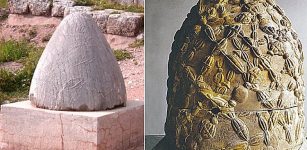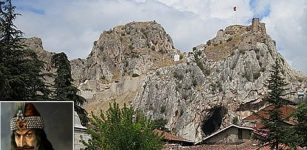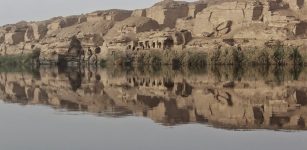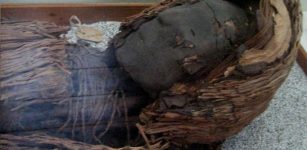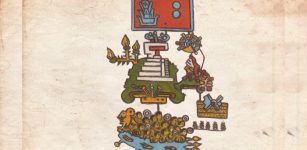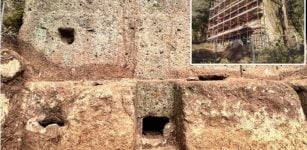Indigenous Village Estimated To Be 11,000 Years Old – Discovered Near Sturgeon Lake
Conny Waters – MessageToEagle.com – An archaeological discovery near Sturgeon Lake First Nation is reshaping history and challenging narratives about early Indigenous civilizations in North America.
The site is located about five kilometres north of Prince Albert along the North Saskatchewan River. Image credit: Sturgeon Lake First Nation
Archaeologists, among them Dr. Glenn Stuart, PhD, from the Department of Anthropology at the University of Saskatchewan, collaborated with the community to conduct a study on one of the continent’s most ancient Indigenous sites.
The team says that the 11,000-year-old pre-contact settlement confirms that highly organized societies existed in the region far earlier than previously believed.
This positions it alongside some of the world’s most renowned ancient sites, including the Great Pyramids of Egypt, Stonehenge in England, and Göbekli Tepe in Turkey. Each of these sites is celebrated for their profound historical importance and their influential role in the development of human civilization.
The Âsowanânihk Council, meaning “A Place to Cross” in Cree, is is focused on protection and study the site with archaeologists from the University of Saskatchewan and the University of Calgary. The council – with educators, youth, Elders, Knowledge Keepers, and academics – is committed to preserving the site.
The ancient site is situated approximately five kilometers north of Prince Albert, along the North Saskatchewan River. It was initially identified by researcher and avocational archaeologist Dave Rondeau. During his survey of the area, Rondeau observed considerable erosion along the riverbank, which had revealed several artifacts.
North Saskatchewan river, Edmonton, Alberta. Image credit: Joli Rumi – CC BY-SA 4.0
“The moment I saw the layers of history peeking through the soil, I felt the weight of generations staring back at me,” Rondeau said. “Now that the evidence has proven my first instincts, this site is shaking up everything we thought we knew and could change the narrative of early Indigenous civilizations in North America.”
On Jan. 31, a team met with the council at Sturgeon Lake’s Cultural Centre, including Dr. Andrea Freeman from the University of Calgary, Dr. Glenn Stuart from the University of Saskatchewan, archaeologist Butch Amundson, and student Jayda Boux leading research on the site’s lithic materials.
The evidence uncovered at the site paints a vivid picture of a thriving long-term settlement, far more than just a fleeting hunting camp. Among the remarkable findings are stone tools, fire pits, and lithic materials that speak to the ingenuity and resourcefulness of its early inhabitants. The layers of charcoal reveal a sophisticated practice of fire management, beautifully aligning with enduring Indigenous oral traditions.
“Evidence suggests the site was a long-term settlement rather than a temporary hunting camp. Findings include stone tools, fire pits, and lithic materials used in toolmaking.” Image credit: Sturgeon Lake First Nation
Moreover, the discovery of large bison remains offers profound insights into ancient hunting techniques and the fascinating evolution of this majestic species. This site stands as an inspiring testament to human resilience and innovation across generations.
Dr. Stuart stated, that “this discovery poses a significant challenge to the antiquated notion that early Indigenous peoples were exclusively nomadic. The evidence indicating long-term settlement and land stewardship suggests a profound and enduring presence. Furthermore, it prompts a reevaluation of the Bering Strait Theory, lending credence to oral histories asserting that Indigenous communities have inhabited this region for innumerable generations.”
The landscape, formed over millennia by glacial activity and extensive flooding, has undergone significant changes. Researchers have identified the site, which currently resembles a buffalo jump, as having been home to several bison pounds and kill sites. Evidence indicates that early Indigenous hunters strategically harvested bison here, including the now-extinct Bison antiquus species, which could weigh up to 2,000 kilograms.
The site offers compelling evidence of the profound and lasting presence of Indigenous peoples in this region, reinforcing the knowledge that has been passed down through generations. Oral histories have consistently depicted the area as a vital cultural and trade hub, and this discovery provides tangible proof that substantiates those narratives.
“This discovery is a powerful reminder that our ancestors were here, building, thriving, and shaping the land long before history books acknowledged us,” said Chief Christine Longjohn. “For too long, our voices have been silenced, but this site speaks for us, proving that our roots run deep and unbroken. It carries the footsteps of our ancestors, their struggles, their triumphs, and their wisdom. Every stone, and every artifact, is a testament to their strength. We are not just reclaiming history-we are reclaiming our rightful place in it.”
The Âsowanânihk Council plans to work with archaeologists to secure funding for ongoing research and preservation. They aim to establish a cultural interpretive center for education, tourism, and community engagement. The council is committed to involving youth in land-based learning to strengthen cultural knowledge and connections.
The site, despite its immense significance, is currently under threat from logging and industrial activities.
The Âsowanânihk Council, with Elder Willie Ermine among its members, has expressed concerns about the potential destruction of this area and is actively advocating for immediate protective measures. Both the Sturgeon Lake First Nation and the council are urging local, provincial, and national stakeholders to join in efforts to safeguard and study this historic site.
Sturgeon Lake First Nation, a distinguished member of Treaty 6, is home to the Plains Cree people who have longstanding connections to Saskatchewan’s boreal forests. Situated 30 kilometers northwest of Prince Albert, this community actively maintains its inherent and Treaty rights while focusing on the preservation of its land, language, and cultural heritage. With a membership exceeding 3,270 individuals, Sturgeon Lake First Nation is committed to promoting self-determination, enhancing educational opportunities, and fostering economic development.
Written by Conny Waters – MessageToEagle.com – AncientPages.com Staff Writer




